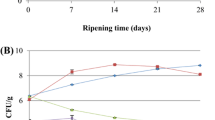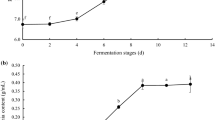Abstract
The effect of a multiple strain starter (KSL: Kocuria varians, Staphylococcus xylosus and Lactobacillus sakei) on the quality of soppressata molisana was investigated during 50 days of ripening. When compared with control batches (C, traditional production without starter and KS, addition of K. varians and S. xylosus as starter), soppressata produced with KSL showed positive results in terms of proteolysis progression, reduction of biogenic amines (BA) and sensory features. The partial substitution of 50 % NaCl with 50 % KCl further improved the quality of soppressata molisana produced with KSL as starter. In fact, the K+ ions seemed to stimulate the growth of added bacteria, with a resulting additional lowering of the pH and BA formation, and higher proteolysis. Moreover, the addition of KCl did not alter the sensory profile of final products. The analysis of data collected during the fermentation and the drying phases, which followed one other, allowed the individuation of different proteolytic events. Specifically, the proteolysis of the myofibrillar fraction occurred more slowly than that of the sarcoplasmic one. Also, the analysis of fractionated muscle proteins allowed to appreciate that sarcoplasmic proteins were hydrolyzed by both endogenous and microbial enzymes, whereas myofibrillar proteins showed a higher resistance to microbial enzymes, and were primarily hydrolyzed by endogenous ones. In conclusion the combined use of KSL and KCl as partial substitute of NaCl, allowed the production of soppressata molisana having an excellent quality, and features consistent with the guidelines of WHO on the sodium and potassium intake.





Similar content being viewed by others
References
Lücke FK (2000) Utilization of microbes to process and preserve meat. Meat Sci 56:105–115
Coppola R, Iorizzo M, Giagnacovo B, Sorrentino A, Sorrentino E, Corino C, Grazia L (1995) La soppressata molisana: caratteristiche microbiologiche e tecnologiche. Ind Aliment 34:851–854
Coppola R, Iorizzo M, Saotta R, Sorrentino E, Grazia L (1997) Characterization of micrococci and staphylococci isolated from soppressata molisana, a Southern Italy fermented sausage. Food Microbiol 14:47–53
Coppola R, Giagnacovo B, Iorizzo M, Grazia L (1998) Characterization of lactobacilli involved in the ripening of soppressata molisana, a typical southern Italy fermented sausage. Food Microbiol 15:347–353
Aro-Aro JM, Nyam-Osor P, Tsuji K, Shimada K, Fukushima M, Sekikawa M (2010) The effect of starter cultures on proteolytic changes and amino acid content in fermented sausages. Food Chem 119(1):279–285
Freiding S, Gutsche KA, Ehrmann MA, Vogel RF (2011) Genetic screening of Lactobacillus sakei and Lactobacillus curvatus strains for their peptidolytic system and amino acid metabolism, and comparison of their volatilomes in a model system. Syst Appl Microbiol 34(5):311–320
Blom H, Hagen BF, Pedersen BO, Holck AL, Axelsson L, Naes H (1996) Accelerated production of dry fermented sausage. Meat Sci 43:S229–S242
Leroy F, Verluyten J, De Vuyst L (2006) Functional meat starter cultures for improved sausage fermentation. Int J Food Microbiol 106:270–285
Suzzi G, Gardini F (2003) Biogenic amines in dry fermented sausages: a review. Int J Food Microbiol 88:41–54
Trani A, Gambacorta G, Loizzo P, Alviti G, Schena A, Faccia M, Aquilanti L, Santarelli S, Di Luccia A (2010) Biochemical traits of Ciauscolo, a spreadable typical Italian dry-cured sausage. J Food Sci 75:C514–C524
Basso AL, Picariello G, Coppola R, Tremonte P, Spagna Musso S, Di Luccia A (2004) Proteolytic activity of Lactobacillus sakei, Lactobacillus farciminis and Lactobacillus plantarum on sarcoplasmic proteins of pork lean. J Food Biochem 28:195–212
Picariello G, De Martino A, Mamone G, Ferranti P, Addeo F, Faccia M, Spagna Musso S, Luccia Di (2006) A proteomic study of muscle sarcoplasmic proteins using AUT-PAGE/SDS-PAGE as two-dimensional gel electrophoresis. J Chromatog 833:101–108
Nicastro A, La Gatta B, Picariello G, De Marzo D, Lamacchia C, Di Luccia A (2013) Proteolysis in fermented and not fermented dry cured salami. Prog Nutr 4:280–283
Armenteros M, Aristoy MC, Barat JM, Toldrá F (2009) Biochemical changes in dry-cured loins salted with partial replacements of NaCl by KCl. Food Chem 117:627–633
Doyle ME, Glass KA (2010) Sodium reduction and its effect on food safety, food quality, and human health. Compr Rev Food Sci F 9(1):44–56
Ruusunen M, Puolanne E (2005) Reducing sodium intake from meat products. Meat Sci 70(3):531–541
Jiménez-Colmenero F, Carballo J, Cofrades S (2001) Healthier meat and meat products: their role as functional foods. Meat Sci 59:5–13
WHO (2012) Guideline: sodium intake for adults and children. World Health Organization, Geneva
Aliño M, Grau R, Baigts D, Barat J (2009) Influence of sodium replacement on the salting kinetics of pork loin. J Food Eng 95(4):551–557
Zanardi E, Ghidini S, Conter M, Ianieri A (2010) Mineral composition of Italian salami and effect of NaCl partial replacement on compositional, physico-chemical and sensory parameters. Meat Sci 86(3):742–747
Lorenzo JM, Cittadini A, Bermúdez R, Munekata PE, Domínguez R (2015) Influence of partial replacement of NaCl with KCl, CaCl2 and MgCl2 on proteolysis, lipolysis and sensory properties during the manufacture of dry-cured lacòn. Food Control 55:90–96
WHO (2012) Guideline: potassium intake for adults and children. World Health Organization, Geneva
Aljuraiban GS, Chan Q, Brown IJ, Griep LMO, Daviglus ML, Stamler J, Van Horn L, Holmes E, Elliott P, Frost GS (2012) 182 association of number of daily eating episodes with blood pressure and nutrient intake: intermap study. J Hypertension 30:e54–e55
Gelabert J, Gou P, Guerrero L, Arnau J (2003) Effect of sodium chloride replacement on some characteristics of fermented sausages. Meat Sci 65:833–839
Donfrancesco C, Ippolito R, Lo Noce C, Palmieri L, Iacone R, Russo O et al (2012) Excess dietary sodium and inadequate potassium intake in Italy: results of the MINISAL study. Nutr Metab Cardiovasc Dis. doi:10.1016/j.numecd.2012.04.004
Campanozzi A, Avallone S, Barbato A, Iacone R, Russo O, De Filippo G, D’Angelo G, Pensabene L, Malamisura B, Cecere G, Micillo M, Francavilla R, Tetro A et al (2015) High sodium and low potassium intake among Italian Children: relationship with age, body mass and blood pressure. PLoS One 10(4):e0121183
Di Maria S, Basso AL, Santoro E, Grazia L, Coppola R (2002) Monitoring of Staphylococcus xylosus DSM 20266 added as starter during fermentation and ripening of soppressata molisana, a typical Italian sausage. J Appl Microbiol 92:158–164
Tremonte P, Succi M, Di Renzo T, Reale A, Sorrentino E, Coppola R (2007) Interactions between strains of Staphylococcus xylosus and Kocuria varians isolated from fermented meats. J Appl Microbiol 103:743–751
Sorrentino E, Tremonte P, Capobianco F, Succi M, Reale A, Di Renzo T, Coppola R (2007) Rapporti di interazione tra microrganismi di interesse tecnologico isolati da soppressata molisana. Ind Aliment 46:633–636
Tremonte P, Reale A, Di Renzo T, Tipaldi L, Di Luccia A, Coppola R, Sorrentino E E, Succi M (2010) Interactions between Lactobacillus sakei and CNC (Staphylococcus xylosus and Kocuria varians) and their influence on proteolytic activity. Lett Appl Microbiol 51:586–594
Nazzaro F, Di Luccia A, Tremonte P, Grazia L, Sorrentino E, Maurelli L, Coppola R (2004) Evaluation of proteolytic activity of staphylococci in soppressata molisana, a typical Southern Italy fermented sausage. Ann Microbiol 54:269–281
Tremonte P, Tipaldi L, Succi M, Pannella G, Falasca L, Capilongo V, Coppola R, Sorrentino E (2014) Raw milk from vending machine: effects of boiling, microwave treatment and refrigeration on microbiological quality. J Dairy Sci 97:3314–3320
Coppola R, Succi M, Sorrentino E, Iorizzo M, Grazia L (2003) Survey of lactic acid bacteria during the ripening of Caciocavallo cheese produced in Molise. Lait 83:211–222
Reale A, Di Renzo T, Succi M, Tremonte P, Coppola R, Sorrentino E (2011) Identification of lactobacilli isolated in traditional ripe wheat sourdoughs by using molecular methods. World J Microbiol Biotechnol 27:237–244
Di Luccia A, Picariello G, Cacace G, Scaloni A, Faccia M, Liuzzi V, Alviti G, Spagna Musso S (2005) Proteomic analysis of water soluble and myofibrillar protein changes occurring in dry-cured hams. Meat Sci 69:479–491
Vinci G, Antonelli ML (2002) Biogenic amines: quality index of freshness in red and white meat. Food Control 13:519–524
Meilgaard M, Civille GV, Carr BT (1999) Sensory evaluation techniques, 3rd edn. CRC PRESS, Boca Raton
Berlitz HD, Grosh W, Schieberle P (2009) Food chemistry, 4th revised and extended edition. Springer, GmbH, Berlin, Heidelberg
Kato H, Rhue MR, Nishimura T (1989) Role of free amino acids and peptides in food taste. In: Teranishi R, Buttery RG, Shahidi F (eds) Flavor chemistry. American Chemical Society, Washington
Ibañez C, Quintanilla L, Cid C, Astiasaran I, Belle J (1996) Dry fermented sausages elaborated with Lactobacillus plantarum-Staphylococcus carnosus Part I: effect of partial replacement of NaCl with KCl on the stability and the nitrosation process. Meat Sci 44:227–234
Zanardi E, Ghidini S, Conter M, Ianieri A (2010) Mineral composition of Italian salami and effect of NaCl partial replacement on compositional, physico-chemical and sensory parameters. Meat Sci 86:742–747
Bover-Cid S, Izquierdo-Pulido M, Vidal-Carou MC (1999) Effect of proteolytic starter cultures of Staphylococcus spp. on biogenic amine formation during the ripening of dry fermented sausages. Int J Food Microbiol 46:95–104
Fadda S, Anglade P, Baraige F, Zagorec M, Talon R, Vignolo G, Champomier-Vergès MC (2010) Adaptive response of Lactobacillus sakei 23 K during growth in the presence of meat extracts: a proteomic approach. Int J Food Microbiol 142:36–43
Spaziani M, Del Torre M, Stecchini ML (2009) Changes of physicochemical, microbiological, and textural properties during ripening of Italian low-acid sausages. Proteolysis, sensory and volatile profiles. Meat Sci 81:77–85
Gou P, Guerrero L, Gelabert J, Arnau J (1996) Potassium chloride, potassium lactate and glycine as sodium chloride substitutes in fermented sausages and in dry-cured pork loin. Meat Sci 42:37–48
Ohmizo C, Yata M, Katsu T (2004) Bacterial cytoplasmic membrane permeability assay using ion-selective electrodes. J Microbiol Methods 59:173–179
Flores M, Toldrá F (2011) Microbial enzymatic activities for improved fermented meats. Review. Trends Food Sci Technol 22:81–90
Kunji ER, Mierau I, Hagting A, Poolman B, Konings WN (1996) The proteolytic systems of lactic acid bacteria. Antonie Van Leeuwenhoek 70:187–221
Fadda S, Sanz Y, Vignolo G, Aristoy MC, Oliver G, Toldrá F (1999) Characterization of muscle sarcoplasmic and myofibrillar protein hydrolysis caused by Lactobacillus plantarum. Appl Environ Microbiol 65:3540–3546
Xie C, Wang H, Nie X, Chen L, Deng S, Xu X (2015) Reduction of biogenic amine concentration in fermented sausage by selected starter cultures. CyTA J Food. doi:10.1080/19476337.2015.1005027
Latorre-Moratalla ML, Bover-Cid S, Bosch-Fusté J, Veciana-Nogués MT, Vidal-Carou MC (2014) Amino acid availability as an influential factor on the biogenic amine formation in dry fermented sausages. Food Control 36:76–81
Author information
Authors and Affiliations
Corresponding author
Ethics declarations
Conflict of interest
The authors declare that they have no conflict of interest.
Compliance with ethics Requirements
No human participants and animals were involved.
Rights and permissions
About this article
Cite this article
Di Luccia, A., Tremonte, P., Trani, A. et al. Influence of starter cultures and KCl on some biochemical, microbiological and sensory features of soppressata molisana, an Italian fermented sausage. Eur Food Res Technol 242, 855–867 (2016). https://doi.org/10.1007/s00217-015-2591-y
Received:
Revised:
Accepted:
Published:
Issue Date:
DOI: https://doi.org/10.1007/s00217-015-2591-y




